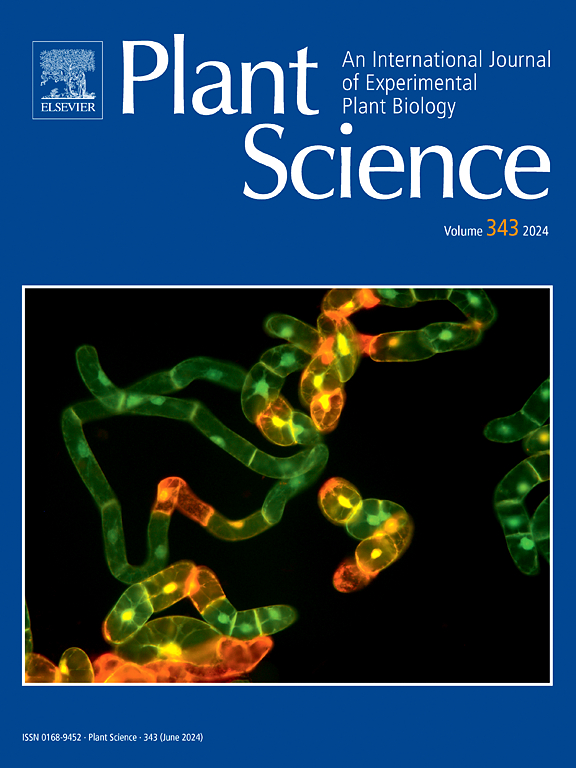Co-overexpression of OsSIZ1 and LtRCA in Arabidopsis thaliana improves heat, drought, and salt tolerance
IF 4.2
2区 生物学
Q2 BIOCHEMISTRY & MOLECULAR BIOLOGY
引用次数: 0
Abstract
Abiotic stresses such as heat and drought are major constraints to plant growth and development, which result in tremendous decline in agricultural productivity. The concomitant occurrence of these stresses is common in nature and can lead to bigger losses in crop yield. Hence, implementing a rigorous approach to enhance abiotic stress tolerance is urgently needed. Multi-gene stacking through genetic engineering is considered to be an effective method that could increase abiotic stress tolerance. Previously, it was shown that overexpression of OsSIZ1 increased heat, drought, and salt tolerance in transgenic plants. It was recently shown that overexpression of LtRCA, a Rubisco activase gene from Larrea tridentata, could increase heat tolerance in Arabidopsis. In this study, we demonstrated that co-overexpression of OsSIZ1 and LtRCA significantly enhances abiotic stress tolerance, particularly under combined drought and heat stress conditions. Notably, OsSIZ1/LtRCA co-overexpressing plants produced at least eight times more seeds and significantly greater biomass compared to wild-type plants, outperforming other transgenic plants. Under individual stress conditions, they yielded six times more seeds under drought stress and three times more under heat stress conditions than wild-type plants. These findings highlight the effectiveness of pyramiding beneficial genes as a powerful strategy to confer broad-spectrum stress resilience in plants.
拟南芥中OsSIZ1和LtRCA的共同过表达提高了耐热、干旱和耐盐性
高温和干旱等非生物胁迫是植物生长发育的主要制约因素,导致农业生产力大幅下降。这些压力的同时发生在自然界中是常见的,并可能导致作物产量的更大损失。因此,迫切需要实施严格的方法来提高非生物胁迫耐受性。通过基因工程进行多基因叠加被认为是提高非生物抗逆性的有效方法。先前的研究表明,OsSIZ1的过表达增加了转基因植物的耐热性、耐旱性和耐盐性。最近的研究表明,tridentata Larrea Rubisco激活酶基因LtRCA的过表达可以提高拟南芥的耐热性。在这项研究中,我们证明了OsSIZ1和LtRCA的共同过表达显著增强了非生物胁迫耐受性,特别是在干旱和热胁迫联合条件下。值得注意的是,与野生型植物相比,OsSIZ1/LtRCA共过表达植物的种子产量至少是野生型植物的8倍,生物量显著增加,表现优于其他转基因植物。在个体胁迫条件下,它们在干旱胁迫下的种子产量是野生型植物的6倍,在热胁迫条件下的种子产量是野生型植物的3倍。这些发现强调了金字塔化有益基因作为一种赋予植物广谱胁迫恢复力的强大策略的有效性。
本文章由计算机程序翻译,如有差异,请以英文原文为准。
求助全文
约1分钟内获得全文
求助全文
来源期刊

Plant Science
生物-生化与分子生物学
CiteScore
9.10
自引率
1.90%
发文量
322
审稿时长
33 days
期刊介绍:
Plant Science will publish in the minimum of time, research manuscripts as well as commissioned reviews and commentaries recommended by its referees in all areas of experimental plant biology with emphasis in the broad areas of genomics, proteomics, biochemistry (including enzymology), physiology, cell biology, development, genetics, functional plant breeding, systems biology and the interaction of plants with the environment.
Manuscripts for full consideration should be written concisely and essentially as a final report. The main criterion for publication is that the manuscript must contain original and significant insights that lead to a better understanding of fundamental plant biology. Papers centering on plant cell culture should be of interest to a wide audience and methods employed result in a substantial improvement over existing established techniques and approaches. Methods papers are welcome only when the technique(s) described is novel or provides a major advancement of established protocols.
 求助内容:
求助内容: 应助结果提醒方式:
应助结果提醒方式:


